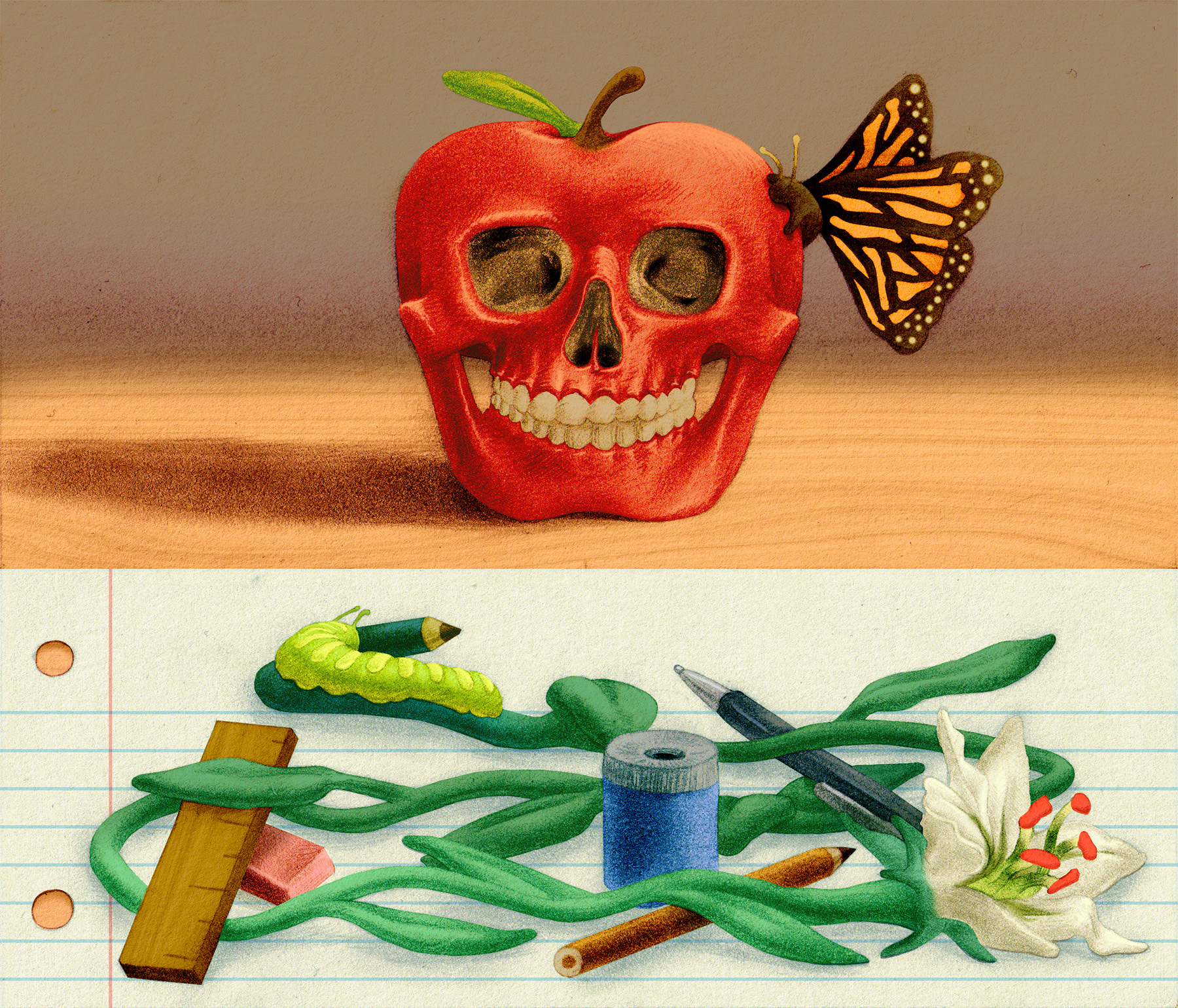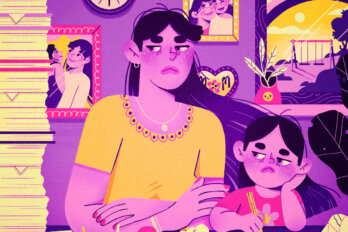In early 2020, Jade Rabley was enjoying a fun job in the big city, working in HR for an entertainment company in Toronto. But, as the COVID-19 pandemic struck, she felt she had cheated herself because she wasn’t doing what she truly wanted to. So she went back to King’s University College at Western University, in London, Ontario, to further her study of death.
Almost six years earlier, at twenty-four, Rabley had walked into her first-ever class in the university’s department of thanatology, a discipline whose name comes from the Greek word for death. The class was part of a conglomerate of first-year courses that had piqued her interest. The auditorium was bland and dreary; she expected the class to be equally sombre. But the course was thrilling, the professor gentle, and the discussion deep. Anyone who gains a thorough understanding of loss, dying, and grief, the professor once noted to her class, can comfort people who are suffering. Rabley believed that she was being granted integral wisdom. Except there was an uncomfortable reality: at the mere mention of death, she felt physically ill.
Throughout her first year, she hung in, feeling an increasingly strong pull to pursue a vocation that embraces death: a job in a caring profession, perhaps as a psychotherapist. Instead of quitting, she took more courses. In one, Children and Death: Theory and Interventions, that most unsettling subject was presented so warmly that, instead of feeling repulsed, Rabley felt inspired. “I can be absolutely terrified and not talk about death,” she said, “or I can educate myself and others and make a difference.”
Before COVID-19, it was easier to think of death as abstract, as only for people later in life or facing illness. But, for more than two years, we have all lived with constant reminders of what Leonard Cohen meant when he sang, “We are so lightly here”: masks, shutdowns, a grim daily count of the dead, the wary way we walk around one another. Truth, like the mask, is literally in our face.
It’s no wonder anxiety is up. Cultural anthropologist Ernest Becker, in his 1974 Pulitzer Prize–winning book, The Denial of Death, declared that the fear of death is the basic force unconsciously lurking behind our actions, both as individuals and as civilizations. Social scientists in the decades since have proven him right. And behaviours during the pandemic have matched what is expected to arise when death becomes hard to deny. Shopping is up. TV watching is up. Drinking is up. These outlets allow us to focus on something—anything—other than the stark fact of life.
Instead of succumbing to distractions, Rabley turned to face her fear. She and other students have entered the thanatology program and graduated as stronger, happier people. They are like children who, afraid of a monster under the bed, don’t stay quietly terrified but climb down to give the darkness a good, long look. All of which raises the question: What do they know that many of us don’t?
In 1976, King’s University College launched a course called Thanatology 101: Death and Dying. It proved so popular that another course on the subject was added, and then another. Still, students wanted more, so an entire department was created. King’s is the only school in Canada and the United States offering a thanatology degree to undergraduates. This academic year, twenty-six courses were offered, including Popular Culture and Death, Creative Responses to Loss and Grief, and Spiritual and Philosophical Issues in Death, Dying, and Bereavement. Five hundred and sixty-two students signed up for at least one course, and fifty-two graduated with thanatology degrees.
The program, like other undergraduate degrees, involves academic rigour: there are theories to understand, histories to know, case studies to weigh, and textbooks to read. Papers and exams must be written, with marking based on specific rubrics. Other first-year undergraduate arts students are asked to write papers about Plato or Jane Austen; thanatology students need knowledge and skills but also a refined existential sensibility.
According to Eunice Gorman, chair of the King’s thanatology department, a student’s interest in studying loss and death is sometimes sparked by a personal loss of one kind or another—often a grandparent or a pet. In some classes, students share their own experiences of loss and grief. “Death is a heck of a lot less scary,” Gorman says, “if you look at it, talk about it, and learn how to support people.”
The program’s introductory course sometimes includes teenagers right out of high school. Mackenzie Moyer was in grade twelve when she and her mother went to a career fair. The colourful booths included one with “thanatology” emblazoned on a banner. Moyer’s mother had to explain what the word meant.
Moyer’s immediate reaction: “Cool!” She grew up in a house where talking about death was encouraged. “Loss affects everything we do,” she says. “At school, a lot of courses had death and nondeath losses mixed together. We studied and talked about how there is no hierarchy. Someone’s pet can die; someone’s mom can die. The loss of divorce, of moving houses, of anything. It isn’t death and other losses. It is very much a spectrum.”
Moyer and her classmates got used to friends going speechless or even shuddering when told what they were studying. But learning about grief and dying, Moyer says, is ultimately about living. “I left my classes a little more open, a bit lighter,” she says. “I left wanting to do things I’m passionate about, wanting to help people, wanting to live my life.” After earning a double honours degree in thanatology and psychology in 2016, she now works as the fund development manager for Hospice Halifax.
“No one at age ten says, ‘I want to grow up and be a grief counsellor or funeral director,’” says King’s thanatology assistant professor Carrie Arnold. But many students do one course and are deeply changed by the experience. Their underlying question switches from “What do I want as a job?” to “How do I want to live my life as a whole?” Death becomes not just an eventuality but an intimate part of their lives. “You see the growth; they can’t fake it,” Arnold says. “This program requires us to wrestle with our own losses, our own mortality. We cannot be effective professionals unless we grow ourselves.”
For centuries, death was both familiar and near—dying people were cared for by family and friends. With the rise of medical science and hospitals, though, the culture’s focus shifted heavily to cures. Today, when someone can’t be cured, most of us have little idea how to respond. It’s almost as if dying, rather than being seen as a normal part of life, is considered something of a failure. How many obituaries begin by announcing that someone has “lost a battle”?
Our understanding of loss and death has never been static. New concepts rise—such as ecological grief, the helplessness people feel while living on a struggling planet, and chronic sorrow, a grief that lasts for years and years. The King’s program has grown and adapted. Several new courses are currently proposed: Grief Activism would explore the use of public grief, mourning, and commemoration in social movements around the world. (An example: women who had personally suffered loss founded Mothers Against Drunk Driving and, against tremendous odds, changed a culture.) The Role of Death Doulas would examine how we can provide care for individuals and their families at end of life. Dark Tourism would look at sites linked to genocide, assassination, incarceration, war, or disaster—natural or accidental—and consider how these places inform our understanding of death, loss, grief, and national and international histories.
The point is not to replace the fear of death with an obsession with death; it is to accept death as a basic fact. Russian composer Dmitri Shostakovich wondered if fear of death is our deepest feeling; he also believed that thinking about death was key to better living. Evidence of the fact that he deeply considered his own death can be heard in his more meditative music. “If people began thinking about death sooner,” Shostakovich once said, “they’d make fewer foolish mistakes.”
Death coming close can bring out our worst or our best. Studies show that some of us, faced with the fact of death, become more humble and grateful. Exploring death and grief has given thanatology students the courage to be uncomfortable, to lean in to situations most of us seek to avoid. By introspectively studying challenging material, students can move through fear to the point where they can help others—and themselves.
Of all her courses, Children and Death applied most to Jade Rabley’s life beyond school. She completed her honours specialization in thanatology in April 2021 and now cares for sick and dying children and their families at Victoria Hospital in London. School, she says, “helped me channel my compassion in a way that’s important. To have the opportunity to connect and sit with people in these unimaginable moments—it’s humbling.” Despite being surrounded by tragedy and loss at the hospital, she marvels every day at the human penchant for bravery and beauty.
Her studies, she says, enabled her to discover that she has the ability to work in this demanding, delicate field. “Dying is such an intimate process,” she says. “Every family is different; everyone is so vulnerable. You are trying to help everybody, and later you go back to your office and cry. Ultimately, though, I feel grateful to be able to support each family in such a huge moment of need. There’s nothing like it and nothing else I’d rather do.”






